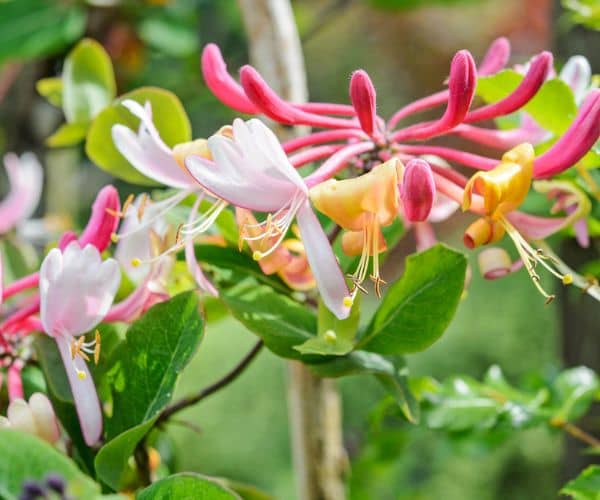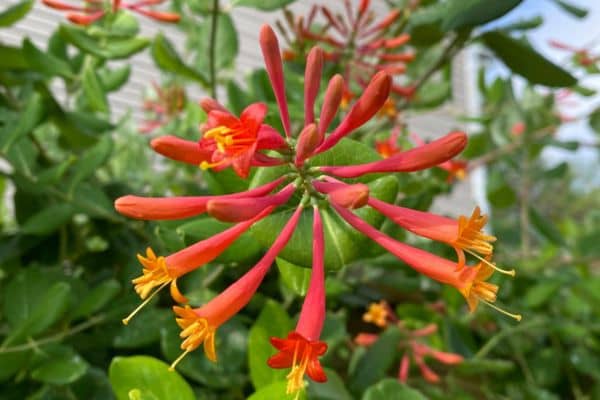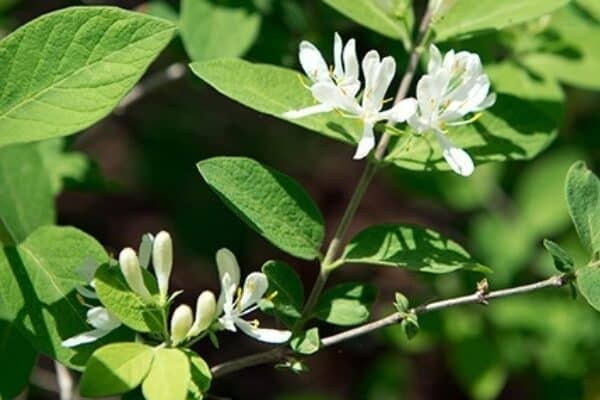Bush honeysuckle are large woody trees that are capable of growing 15 feet tall with long arching branches which grow in a dense shrubby layer
Today, we will share some methods that you can use to plant and grow this invasive shrub bush honeysuckle.
Brief overview of Bush Honeysuckle
Bush Honeysuckle, also known as Lonicera spp, was first introduced to North America as a garden plant in the late 18th century.
Bush Honeysuckle is one of the most aggressive exotic plants that have escaped and naturalized in urban areas. It leafs out early in the spring grows fast and spreads fast. They grow opposite the leaves along the branches.
They become visible in April and May with white fragrant blossoms, and later become yellow as they grow old. Seedling tunks are likely hairy and grayish-brown bark. Furthermore, as these woody plants keep their leaves well into November, it is simple to identify them in the fall. Likewise, the mature plants produce red berries which are eaten by many species of birds and mammals.
Bush Honeysuckle are deciduous perennials with oval-shaped leaves and tubular flower clusters at the tips of their branches. Likewise, they form patched in rocky, dry areas spread by underground stems called rhizomes. Mostly, it blooms in the early summer.
Which is the best place to plant the bush Honeysuckle?
Bush Honeysuckle is very flexible and can be planted anywhere in the yard, whereas it will flower a lot and have better fall foliage coloration if it receives at least half of a day’s worth of sunlight. For a low-growing fence, it works well to space plants two or three feet apart, also it can be planted on mixed shrub borders, in the sun or in partial shade, individually, or in groups in gardens.

If you are planting honeysuckles for better wildlife habitat, place them near existing vegetation or water resources where birds and other wildlife are available.
Moreover, enough space should be ensured for this plant to spread and grow without overcrowding other plants, and also for the proper air circulation and maintenance.
When to plant a Honeysuckle Bush?
The early spring will be the best season to plant your honeysuckle as there will be no longer a chance of frost and you can smell the delightful scent of the plant throughout the summer.
How to plant a honeysuckle at your home?
As there are many types of honeysuckle bushes with different bloom colors and scents, choose the kind of honeysuckle shrub you want to plant.

Let us talk about the care tips and planting the Honeysuckle at your home, since this is a strong plant that grows quickly, let’s start with a bigger flower pot. To prevent the soil from running out, add a broken pot piece with its concave portion facing the drainage hole.
Next, add equal amounts of red soil, compost, and sand of equal proportion, this is because some plants require a little more clay soil than others. Now, remove the plants from the grow bag and loosen any spot-bound roots, then, add the plant to the flower pot, and fill it in.
Don’t put the plant in the pot too deep, and maintain the old soil level. After placing it in the flower pot, cover it with extra compost and water it.
“Keeping Healthy Growth: Care Tips for Your Honeysuckle Bush”
- Sunlight – For an extra bit of care tips, Sunlight is needed to increase its bloom, as many of the species of this plant need support to full or partial sunlight, for best growth and flowering. You will have to choose a spot that gets at least six hours of sunlight per day.
- Watering – As this plant is water-hungry, you need to water it every day making sure the soil is always moist, and not that wet, mostly in the growing season when the plant is forming its root system. Water honeysuckle in the early morning or late afternoon to reduce the chance of fungal disease. Also, make sure not to water it in the evening as it can cause in encouraging the growth of fungi.
- Fertilizing – In the early summer, the Honeysuckle bush needs to be fertilized with a proper and balanced fertilizer to ensure healthy growth and flowering. In addition to this, you can fertilize this plant with compost twice a month, especially during the summer months.
- Pruning – Another important care tip you need to follow for a healthy Honeysuckle bush is Pruning. Every year, honeysuckle bushes require pruning or cutting down to keep their shape, remove dead branches, and promote new growth and blooming.
- Support Pillars – The other important thing to maintain this plant, is to give it strong support like a trellis, or you can also make your own plant guards using wooden branches.
Add the twigs in all directions, and encircle them with twine thread, ultimately this will help the plant to grow faster than it would otherwise.
Types of Honeysuckle Bush-
There are varieties of honeysuckle bushes with their own unique features, growth habitats, and many more. However, it is difficult to mention the exact number of types of this plant, but here are some of the known types of honeysuckle bushes:
- Japanese Honeysuckle/ Lonicera Japonica – Japanese Honeysuckle, golden-silver honeysuckle is a type of honeysuckle that is native to East Asia, It is commonly grown as a decorative plant, known for its fragrant white or yellow flowers that usually bloom in late spring to summer.
- Amur honeysuckle/Lonicera Maackii – It is another species of honeysuckle that is native to eastern Asia, that grows a maximum of 6 meters tall with stems of a maximum of 10 centimeters. But in Japan, this plant has a reputation for being an endangered species. Also, it is famous for its fast growth and dense foliage. In spring, it produces white or yellow flowers and later red berries.
- Tatarian honeysuckle/Lonicera tatarica – It is the type of honeysuckle that is native to Eastern Europe and Western Asia and normally grows as a shrub with multiple stems with a height og 6 feet 10 feet. In the late spring to early summer, it produces fragrant, tube-shaped flowers, typically pink, red, or white in color, which attract pollinators like bees and butterflies.
- Lonicera fragrantissima/Winter honeysuckle – Another type of honeysuckle is Winter honeysuckle, native to China, famous for its early bloom, and great fragrance. The flowers produced by this plant are small creamy white in late spring to early summer.
- Lonicera xylosteum /European fly honeysuckle – It is a species native to Europe and parts of Asia, which usually blooms in late spring to early summer, from May to June. It is also famous for its wildlife-attracting qualities, providing food and home for wildlife and other wildlife.
- Lonicera sempervirens /Trumpet honeysuckle –

Lonicera sempervirens, another species of honeysuckle is native to North America, which normally blooms from late spring to early summer. Also, it is a common pick for gardeners as it attracts hummingbirds, and other pollinators to their landscapes.
FAQs
1. Is honeysuckle harmful to humans?
Yes, the berries of honeysuckle might be slightly harmful to humans, also they have a strong uncomfortable taste.
2. When do honeysuckle bushes bloom?
Honeysuckle bloom time varies by species and its type. Usually, it occurs from late spring to early summer, whereas, some varieties, may bloom earlier or later in the season.
3. Is it possible to grow honeysuckle bushes in flower pots??
Yes, some honeysuckle bushes can be grown in flower pots, especially dense or small plants.
Also read, A Complete Guide To Grow And Care For California Poppy
